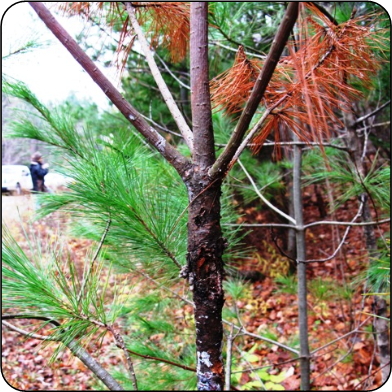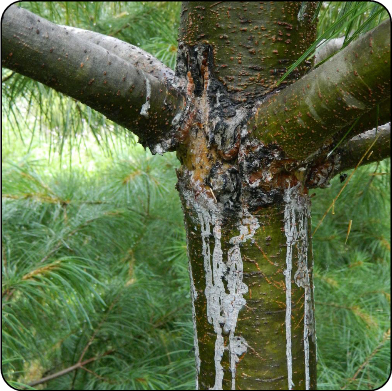White pine blister rust
Information about white pine blister rust ( Cronartium ribicola), a forest rust disease found in Ontario.
Overview
- Invasive – native to Asia.
- White pine blister rust is a fungus that affects eastern white pine.
- It was first discovered in Ontario in 1914 and is believed to have been introduced from Asia to Europe, then to North America.
- Lower branches are more prone to infection and younger trees are at greater risk of mortality.
“Invasive” refers to a species that has moved outside of its native habitat and threatens the new environment, economy or society by disrupting local ecosystems.
Host species
In Ontario, this fungus affects white pine (Pinus strobus). All five-needled pine trees of all ages are susceptible to this disease.
Characteristics and life cycle
- White pine blister rust alternates between two hosts to complete its life cycle: white pine trees and Ribes species (including currant and gooseberries).
- Infection of pine occurs in late summer and early fall, when fungal spores (basidiospores) from a diseased Ribes plant lands on a pine needle, germinates and successfully colonizes the needle.
- Once the needle has been colonized, the fungus grows into the twig and branch tissues for the next 12 to 18 months.
- The following spring, three to six years after the initial infection, white blisters burst through the bark, rupture and release dust like orange spores (aeciospores), which are carried by the wind and infect Ribes leaves.
- The infected Ribes leaves will produce basidiospores which will be dispersed by wind in late August to October, infecting pine and completing the life cycle.

Symptoms and damage
- Blister rust cankers are easy to spot as they release heavy resin.
- Cankers are often spindle-shaped swellings.
- Trees frequently have whole branches containing clusters of needles that are yellow, red or brown in colour, commonly called “flagging”.
- Whole trees may appear yellow or brown in colour and on close inspection reveal a girdling canker at the base.
- In early spring, white and yellow blisters may be seen on the canker.
- Rodents often eat the bark at the margin of the canker.
- The undersides of infected Ribes leaves will contain orange pustules.

Control measures
To avoid blister rust problems when planting white pine, select sites that are:
- south or southwest facing
- containing no Ribes species
- on mid or upper slopes
- dry rather than moist
Updated: July 25, 2022
Published: July 18, 2014